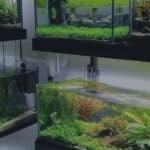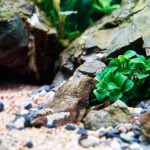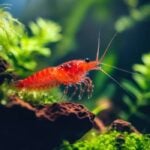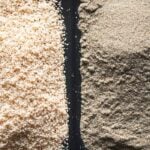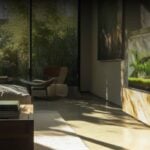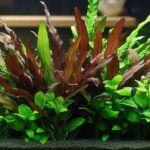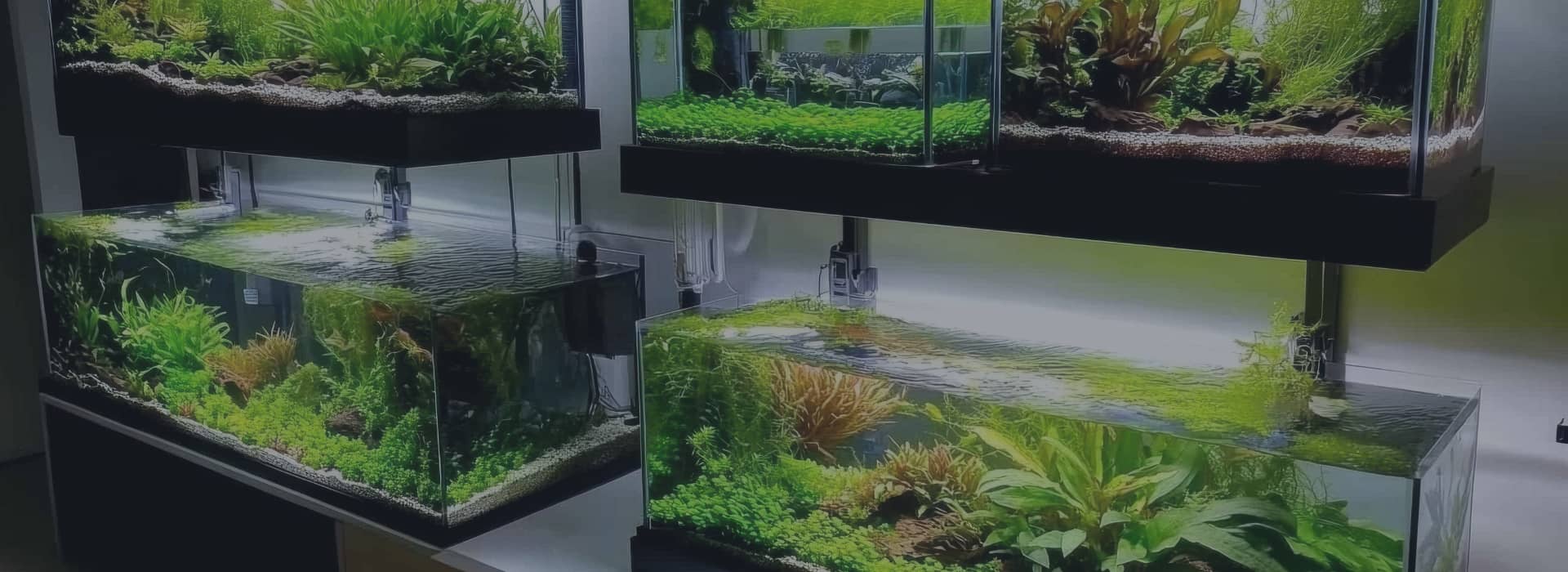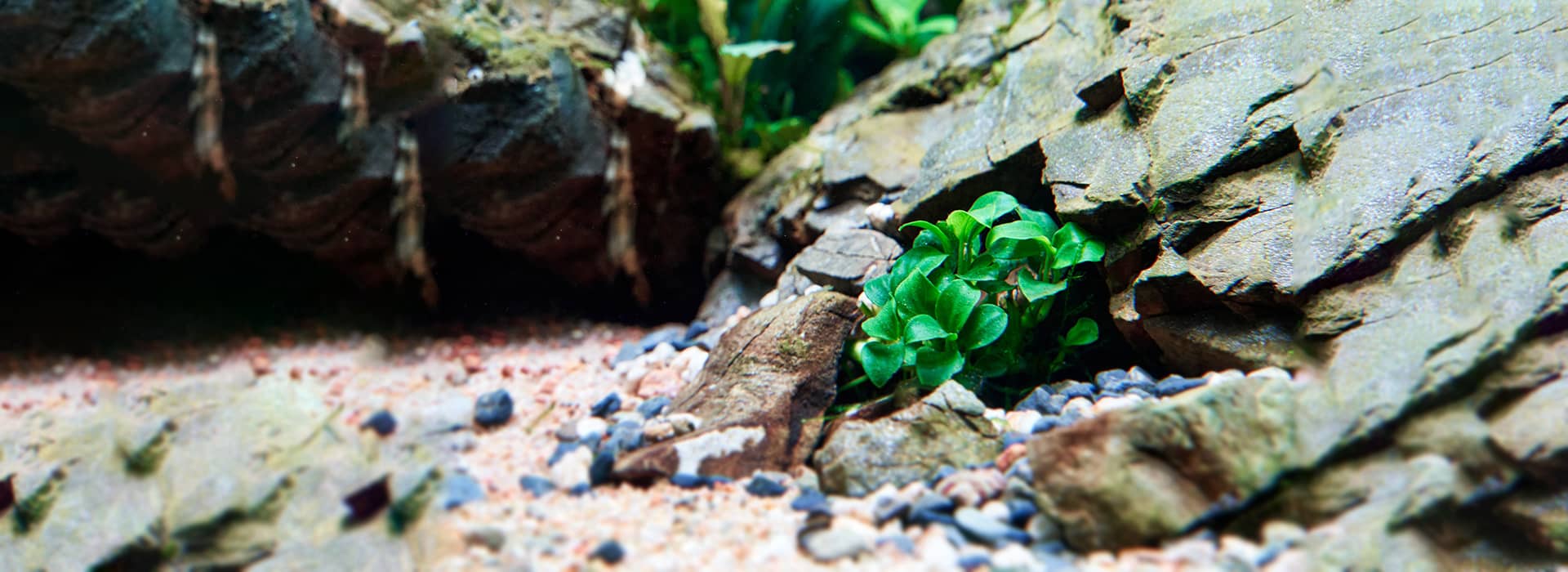Aquascaping is a creative endeavour that transforms aquariums into living art. It means creating a peaceful place that looks like nature with rocks, plants, and soil. When rocks are used as the focal point, they bring structure, texture, and beauty to the underwater landscape.
Aquascaping: The Underwater Artistry
Aquascaping is the practice of arranging aquatic plants, rocks, and other natural materials in an aquarium in an aesthetically pleasing manner.
This hobby is similar to gardening underwater, where you aim to create a balanced ecosystem that sustains life and looks beautiful.
Utilising Rocks as the Hardscape Focal Point
Rocks serve as the backbone of many aquascapes, providing structure and a natural feel to the underwater landscape. They can also create depth, perspective, and focal points within the aquarium.
Here are some ideas for using rocks as the hardscape focal point.
1. The Iwagumi Layout
This minimalist approach, rooted in Japanese Zen gardens, utilises strategically placed rocks to create a simple yet impactful design. Typically, an odd number of rocks is used, with the largest rock serving as the main focal point.
2. The Nature Aquarium
Inspired by natural landscapes, this style uses rocks to mimic mountains, valleys, or riverbeds. Rocks are arranged to guide the viewer’s eye through the aquascape and provide a sense of depth and scale.
3. The Jungle Style
Rocks in a jungle-style aquascape are often partially hidden by lush plant growth, creating a wild and untamed appearance. They can be used to anchor plants or create hiding spots for fish.
4. The Biotope Aquascape
This design seeks to replicate a specific natural environment. Rocks are chosen based on the biotope being recreated, such as river stones for a riverine habitat.
Selecting the Perfect Stones
When it comes to aquascaping, the choice of rocks can significantly impact the aesthetic and ecological balance of your aquarium.
Rocks not only serve as a visual anchor but also provide essential hiding and grazing spots for the aquarium inhabitants. Here are some of the best rocks that can be used to create a stunning hardscape focal point in your aquascape:
1. Dragon Stone (Ohko Stone): The Rugged Charm
Dragon stone, with its rough texture and intriguing shapes, can create a dramatic and naturalistic landscape. It’s also known for its porous nature, which provides an excellent surface for beneficial bacteria to colonize.
2. Seiryu Stone: The Sharp Elegance
Seiryu stones are characterized by their sharp edges and striking blue-grey colouration. They can create a mountainous effect but should be used with caution as they can raise the water’s pH level.
3. River Rocks: The Smooth Wanderers
Smooth and rounded river rocks can create a serene and natural look. They are generally inert and won’t affect the water parameters, making them a versatile choice for any freshwater aquascape.
4. Pagoda Stones: The Structured Layers
Pagoda stones are known for their stratified appearance and can be used to build intricate rock formations. Like Seiryu stones, they can alter the water chemistry and are best suited for aquascapes that require higher pH levels.
Building Your Aquascape
Foundation
Start with a solid foundation of substrate, followed by a layer of sand or gravel. This will not only anchor your rocks but also provide a base for plant growth.
Rock Placement
Strategically place your rocks to form the desired structure. Remember to consider the future growth of plants and the movement of fish when arranging your stones.
Planting Around the Rocks
Select plants that will enhance the rocks without overshadowing them. Carpeting plants can create a lush base, while taller species add depth and height.
Maintenance
Regular care is essential to maintain the beauty of your aquascape. This includes pruning plants, controlling algae, and performing water changes.
Choosing the Right Plants to Complement Your Rock Hardscape
Selecting the right plant species to complement your rock-focused layout is essential. These plants not only add to the aesthetic appeal but also contribute to the ecological balance within the aquarium. Here are some plant species that can thrive in rock-focused aquascapes:
1. Anubias: This genus includes several species that are perfect for attaching to rocks. Anubias plants are hardy and can thrive in a variety of lighting conditions. They have lush, dark green leaves that provide a beautiful contrast against the rocks.
2. Java Fern (Microsorum pteropus): Java Fern is a versatile plant that can be attached to rocks and driftwood. It’s a great background plant for smaller tanks and a midground plant for larger setups. With its broad leaves, it adds a lush backdrop to the hardscape.
3. Bolbitis Heudelotii (African Water Fern): This fern can be tied to rocks and wood, and its dark green, pinnate leaves create a delicate, forest-like appearance in the aquarium.
4. The Wendt’s Water Trumpet ICryptocoryne wendtii): This species is adaptable and can grow in low-light conditions. It’s available in various colours, which can add a nice contrast to the greenery and the rocks.
5. Christmas Moss (Vesicularia montagnei): A type of moss that can be attached to rocks, forming a soft, velvety carpet that enhances the naturalistic feel of the aquascape.
6. Crystalwort (Riccia fluitans): This liverwort can be tied down to rocks, forming a bright green, fluffy cushion that contrasts well with the hardness of the rocks.
7. Dwarf Baby Tears (Hemianthus callitrichoides): A popular carpeting plant that can be attached to rocks, creating a lush, green carpet that’s perfect for the foreground of your aquascape.
8. Dwarf Hygrophila (Hygrophila pinnatifida): This plant can be attached to rocks and wood, and its unique leaf shape and colouration provide an attractive contrast to the hardscape.
9. Flame Moss (Taxiphyllum sp.): This moss has a unique growth pattern that resembles flames, which can add an interesting texture when attached to rocks.
10. Moneywort (Bacopa monnieri): This stem plant can be planted on the substrate or attached to rocks. Its small, round leaves contrast nicely with the rocks’ angular shapes.
11. Weeping Moss (Vesicularia ferriei): Known for its drooping growth pattern, this moss can create a cascading effect over rocks, adding depth and interest to the aquascape.
12. Willow Moss (Fontinalis antipyretica): This moss can be used to create a soft, green texture on rocks, enhancing the natural feel of the aquascape.
These plants are not only aesthetically pleasing but also serve practical purposes, such as sheltering fish and helping to maintain water quality.
When choosing plants for your rock-focused aquascape, consider the growth habits and care requirements to ensure they are compatible with your aquarium conditions and the overall design you wish to achieve.
Common Mistakes to Avoid in Aquascaping with Rocks
Aquascaping is an art form that requires patience, precision, and an understanding of the aquatic environment. When adding rocks to your aquascape, try to avoid common mistakes to ensure a healthy underwater environment. Here are some pitfalls to steer clear of:
1. Lack of Planning
Jumping into aquascaping without a clear plan can lead to a disorganized and unappealing layout. Research and sketch your design beforehand, considering the placement of rocks, plants, and fish to create a cohesive and balanced ecosystem.
2. Overstocking and Inadequate Filtration
Overcrowding your aquarium with fish can lead to excessive waste and poor water quality. Coupled with inadequate filtration, this can cause algae blooms and stress to the inhabitants. Choose fish wisely and ensure your filtration system is up to the task.
3. Improper Rock Selection
Using rocks that alter the water chemistry can harm your plants and fish. Select inert rocks that won’t affect the pH or hardness of the water, and avoid those that may leach harmful substances.
4. Unstable Rock Structures
Creating rock formations without ensuring stability can lead to collapses, potentially damaging your aquarium and harming its inhabitants. To prevent accidents, use techniques like stacking and securing with aquarium-safe adhesives.
5. Neglecting Maintenance
Rocks can accumulate algae and detritus, affecting water quality and aesthetics. Regular maintenance, including cleaning and monitoring of the rocks, is essential to maintain a healthy aquascape.
6. Ignoring Water Parameters
Different fish and plants thrive in specific water conditions. When choosing rocks, consider how they might impact the water parameters and whether they align with the needs of your aquatic life.
7. Poor Lighting
Inadequate lighting can hinder plant growth and the overall health of your aquascape. Ensure your lighting setup caters to the needs of your plants and highlights the beauty of your rockwork.
8. Forgetting Balance and Focal Points
An aquascape should have a point of interest and a balanced layout. Avoid placing rocks haphazardly, as this can lead to a cluttered appearance. Instead, create a focal point and arrange rocks to complement it.
Rock-focused Aquascape: A Living Masterpiece
Aquascaping with rocks as the hardscape focal point is a fascinating and rewarding endeavour.
Whether you opt for the simplicity of the Iwagumi layout or the natural beauty of the jungle style, the key is to balance creativity with the needs of the aquatic life within the aquarium.
With regular maintenance and thoughtful choices, you can enjoy a stunning and harmonious aquascape that captivates the eye and supports a thriving underwater ecosystem.
